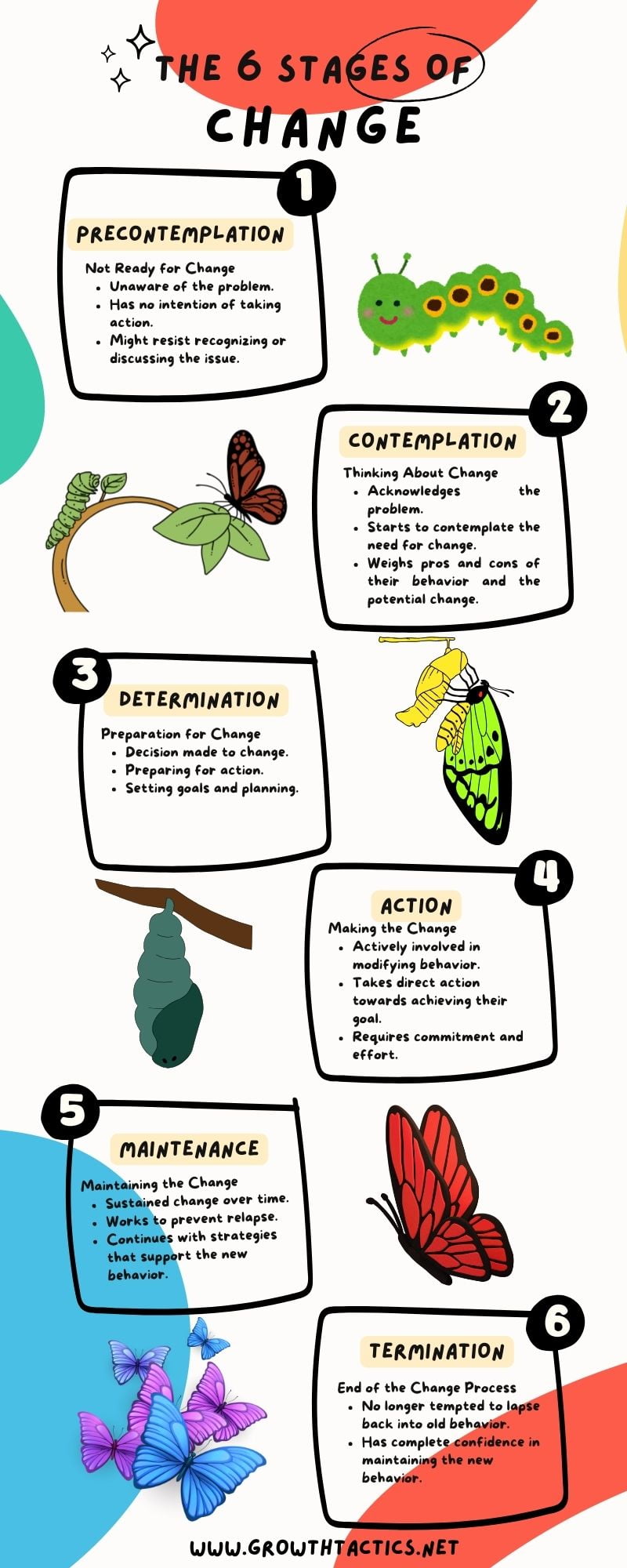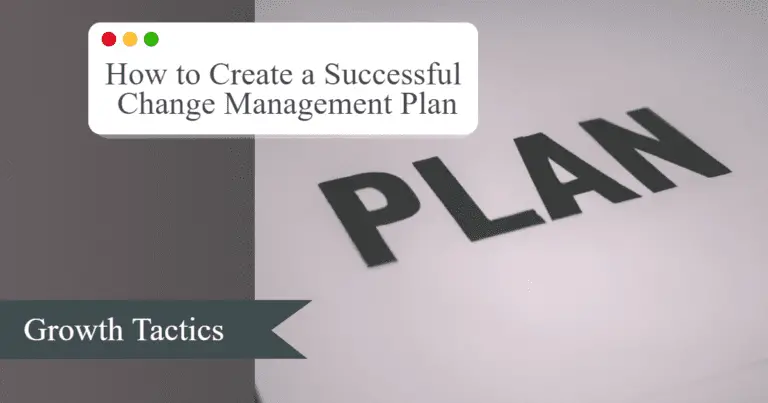Change is the only constant in life, and the same is true for businesses. Every organization goes through various changes that require a structured process, known as change management.
Change management involves following a set of procedures, processes, and tools to help manage the people, processes, and technology side of the business change. This article will guide you through the essential steps to create a successful change management plan for your organization.
Jump To Section
What is a Change Management?
Change management is the structured process of identifying, planning, executing, and adapting to business changes in an organized and controlled manner. It includes the management of stakeholder communications, the training of employees, the development of metrics and KPIs, the development of an implementation plan, the creation of a resistance management plan, and the management of the transition and support of the new state.
Why Do We Need a Change Management Plan?
Having a solid change management plan in place is crucial to avoid confusion, mistakes, or delays during the implementation. A well-planned change management process helps the employees and stakeholders to understand why the change is happening, what it will involve, what their role is, and what support they can expect. The plan also ensures that the change is well-communicated, fully understood, and implemented smoothly, effectively, and efficiently.
Change Management Plan Template
Creating a change management plan template can be a complex process, as it depends on the specific needs and scope of the change for each organization. However, here are some general steps and elements to consider when creating a change management plan template:
1. Introduction
Explain the purpose and scope of the change management plan template, and provide an overview of the planned change.
2. Objectives and Goals
Identify the objectives and goals for the planned change. Outline how these objectives will be achieved, and how progress towards them will be measured.
3. Change Impact and Risk Assessment
Conduct an assessment of the potential risks and impacts associated with the change. Identify stakeholders who may be affected by the change and the extent of their impact. Highlight the risks and challenges that could arise in the project, then provide a mitigation plan to address or manage the risks.
4. Roles and Responsibilities
Assign clear roles and responsibilities to each member of the project team. Define the primary point of contact for the change management project and their responsibilities.
5. Communication Plan
Outline a communication plan to ensure all stakeholders are informed of the change. Identify the key messages that need to be communicated, the stakeholders to communicate to, and the communication channels to be used. Highlight the timing of communications, and the frequency of communication required.
6. Training and Education
Determine any training and education requirements needed to enable stakeholders to adapt to the change. Include details on how the training will be delivered, the timeline for the training, and how feedback will be collected.
7. Change Implementation Plan
Outline an implementation plan that provides a timeline of the change project and key milestones to reach. Define any critical dependencies and the timeline required. Identify specific performance indicators that can be used to determine the success of the change project.
8. Transition Plan
Detail the transition plan to ensure that change management remains relevant after implementation. Identify sustainable and scalable change management practices that will support the new system post-implementation.
9. Review and Update procedures
Define procedures for reviewing and updating the change management plan, creating a feedback loop that can help refine and optimize the process in the future.
A change management plan template can help keep an organization on track and achieve successful change management. As the above steps are general guidelines, the plan can be further tailored according to the specific needs and scope of the change project.

How to Manage Change Effectively
Managing change is a critical skill for business leaders and managers. The ability to navigate and guide your organization through periods of change can make all the difference in achieving successful outcomes. In this section, we’ll explore some key strategies and approaches to help you manage change effectively.
1. Embrace a Positive Mindset
Change can be disruptive and challenging, but it’s important to approach it with a positive mindset. Embracing change as an opportunity for growth and improvement can help you and your team navigate through it more smoothly. Encourage open and transparent communication, and create a supportive environment where everyone feels comfortable sharing their thoughts and concerns.
2. Communicate Clearly and Frequently
Communication is a vital component of effective change management. Ensure that you communicate the reasons for the change, the expected outcomes, and what it means for the organization and individuals involved. Be open to feedback and address any questions or concerns. Regularly update your team on the progress of the change, keeping them informed and engaged throughout the process.
3. Involve and Empower Your Team
Change is best managed when everyone feels involved and empowered. Involve your team in the decision-making process, seeking their input and ideas. This not only creates a sense of ownership but also allows you to tap into the diverse perspectives and expertise within your organization. Empower your team by providing the necessary resources, training, and support to adapt to the change with confidence.
4. Plan and Prioritize
Effective change management requires careful planning and prioritization. Identify the specific objectives and goals of the change, and develop a comprehensive plan with clear milestones and timelines. Break down the change into manageable stages, ensuring that each step is well thought out and supported. Prioritize your actions based on their impact and feasibility, focusing on the most critical areas first.
5. Anticipate and Manage Resistance
Resistance to change is natural and should be expected. Take the time to understand the concerns and fears of those who may resist the change. Address these concerns openly and transparently, providing a clear rationale and outlining the benefits of the change. Foster a culture of support and provide additional training and resources to help individuals adapt to the new way of doing things.
6. Monitor Progress and Adjust
Change is a dynamic process, and it’s essential to monitor its progress and adjust accordingly. Regularly assess the impact of the change and gather feedback from your team. Identify any barriers or challenges that may arise and be prepared to make adjustments to your plan as needed. Celebrate small wins along the way to maintain momentum and keep your team motivated.
7. Lead by Example
As a leader, your actions and attitude will heavily influence how change is received by your team. Lead by example, demonstrating openness to change, adaptability, and a positive attitude. Show your commitment to the process by actively participating in the change and being available to support and guide your team through any difficulties.
By applying these strategies and approaches, you can effectively manage change within your organization. Remember, change is an opportunity for growth and improvement. Embrace it with a positive mindset, communicate openly, involve and empower your team, and be prepared to adapt as needed. With the right approach, you can successfully navigate change and lead your organization to future success.
Useful Change Management Software
Managing change can be a daunting task, but utilizing the right software can make it much easier. In this section, we’ll go over some useful change management software options that can assist you in implementing and monitoring changes effectively.
1. Asana
Asana is a popular project management tool that can be used for change management projects. Its clear project views and user-friendly interface make it easy to assign tasks, track progress, and communicate with team members. Asana’s reporting functions can help keep the team up-to-date and informed on the change progress.
2. Trello
Trello is another project management software that can help you organize change management tasks in a visual way. It enables you to assign tasks, create checklists, and track progress. Trello’s drag-and-drop interface helps to simplify the organization of tasks, making it easy to collaborate with your team members.
3. Smartsheet
When it comes to complex change management projects, Smartsheet is an excellent software choice. It provides extensive project management features such as Gantt charts, time-tracking, and automation. These features help to ensure that complex change projects stay on track and are completed within the projected timelines.
4. Wrike
Wrike is an adaptable project management tool that offers many features relevant to change management projects. It makes collaboration and communication with the team much easier. This software provides extensive functionalities such as team workload balancing tools, progress tracking, and resource allocation. Wrike’s flexible pricing plans ensure it is accessible and affordable for both large and small businesses.
5. Prosci
Prosci Change Management is an extensive change management suite specifically designed for change management projects. It provides best practices, training, and extensive research to assist businesses in navigating change management processes. Prosci’s tools make it possible to manage the human side of change and transform organizations with data-driven insights.
In conclusion, change management can be challenging, however using the right software can make the process much smoother and more effective. These software options provide a great starting point for businesses to manage change with ease. With these tools, you can track progress, organize tasks, and collaborate with others. Find the solution that best suits your specific needs and manage change with confidence.
Steps in the Organizational Change Process
Managing change within an organization can be a complex and challenging task. To navigate this process successfully, it’s essential to follow a structured approach. In this section, we’ll outline the key steps involved in the change process, helping you effectively lead your team through periods of transition.
1. Define the Need for Change
The first step in the change process is to clearly define why change is necessary. Identify the specific problem, opportunity, or goal that requires a different approach. Conduct a thorough assessment of the current situation, gather data, and engage stakeholders to gain a comprehensive understanding of the need for change.
2. Develop a Change Strategy
Once the need for change is defined, it’s crucial to develop a comprehensive change strategy. Determine the desired outcomes, objectives, and goals of the change initiative. Identify the key drivers and potential barriers to change. Create a detailed plan that outlines the actions, resources, and timeline required to achieve the desired results.
3. Communicate the Change
Effective communication is vital for successful change management. Clearly and consistently communicate the reasons for the change, the benefits it will bring, and how it aligns with the organization’s vision and values. Tailor your messaging to different stakeholder groups and address their concerns and questions. Be transparent and open to feedback throughout the process.
4. Plan and Implement Change Activities
With a change strategy in place, it’s time to plan and implement specific change activities. Break down the change initiative into manageable tasks and allocate responsibilities to individuals or teams. Develop a timeline and set clear milestones to track progress. Provide the necessary support, resources, and training to ensure smooth execution of the planned activities.
5. Monitor and Evaluate Progress
As the change initiative is underway, continuously monitor and evaluate progress. Regularly assess whether the change activities are on track and producing the desired outcomes. Collect feedback from stakeholders and adjust the approach as needed. Use key performance indicators (KPIs) to measure success and ensure that the change is contributing to the overall organizational goals.
6. Support and Engage Employees
Change can often be met with resistance, so it’s important to support and engage employees throughout the process. Provide clear communication channels for employees to express their concerns and questions. Offer training and development opportunities to equip them with the skills they need to adapt to the change. Recognize and celebrate milestones along the way to foster motivation and engagement.
7. Implement the Change
The final step in the change process is to embed the change into the fabric of the organization. Ensure that the new processes, systems, and behaviors are integrated into day-to-day operations. Provide ongoing support, monitor performance, and make adjustments as required. Foster a culture of continuous improvement to sustain the change and enable future growth.
By following these steps in the change process, you can effectively lead your organization through periods of transition. Remember, change is a journey, and it requires clear communication, careful planning, and strong leadership. Embrace the change as an opportunity for growth, and navigate the process with a calm and confident demeanor.
Potential Pitfalls of Change Management
Implementing change within an organization is a complex process, fraught with potential challenges. Being aware of common pitfalls can help in planning and executing a more effective change management strategy. Here are several key pitfalls to watch for:
1. Lack of Clear Vision and Objectives
- Pitfall: Without a clear vision or defined objectives, change initiatives can become aimless and lose momentum.
- Solution: Ensure that the change management plan starts with a well-articulated vision and specific, measurable goals. Communicate these objectives clearly to all stakeholders.
2. Inadequate Communication
- Pitfall: Failure to communicate effectively can lead to misunderstandings, resistance, and decreased morale among employees.
- Solution: Develop a robust communication plan that includes regular updates, channels for feedback, and transparent sharing of information about the change process.
3. Insufficient Buy-In from Stakeholders
- Pitfall: Change efforts can be undermined if key stakeholders are not committed to the change.
- Solution: Engage stakeholders early and often. Involve them in planning and decision-making processes to build ownership and support for the change.
4. Underestimating Resistance to Change
- Pitfall: Resistance to change is natural and can derail implementation if not properly managed.
- Solution: Conduct a resistance management assessment and develop strategies to address concerns. Offer training, support, and clear explanations of benefits to mitigate resistance.
5. Poor Resource Allocation
- Pitfall: Change efforts can fail if not enough resources (time, money, personnel) are allocated.
- Solution: Carefully plan resource needs and ensure that they are available and appropriately allocated. Adjust plans as needed to address resource shortages.
6. Lack of Follow-Through
- Pitfall: Initiatives may start strong but falter without sustained effort and monitoring.
- Solution: Develop a follow-up plan to track progress, assess outcomes, and make necessary adjustments. Regular reviews and feedback loops are crucial for sustained success.
7. Ignoring the Cultural Aspect
- Pitfall: Overlooking the cultural impact can result in misalignments and reduced effectiveness.
- Solution: Consider the organizational culture and how the change aligns with or challenges it. Address cultural aspects in the change plan and work towards cultural buy-in.
By anticipating and planning for these potential pitfalls, organizations can enhance their change management efforts and increase the likelihood of successful transformation.
Conclusion
Change is an inherent part of business, and managing it effectively is crucial for the success of any change initiative. Utilizing a properly structured change management plan can help ensure that the change is efficient and implemented successfully.
By following the essential elements and steps outlined in this article, you can create a structured and effective change management plan that can lead to a successful outcome.


